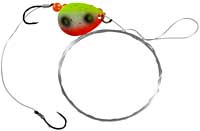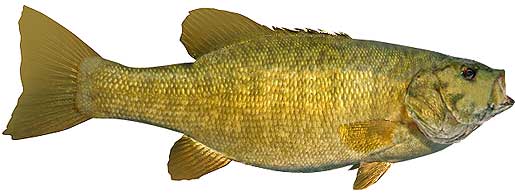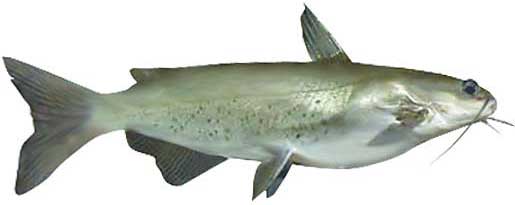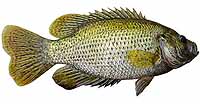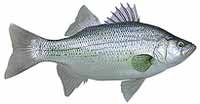Fishing Report For Lewis And Clark Lake, SD
By Rick Seaman
August 8, 2025

Fishing Reports
Popular Fish Species Lewis And Clark Lake, SD
Walleye
Current Report: Good To Very Good
Spring and Fall are the best seasons for catching walleye, as they spend a more time shallow.
SUMMER. Currently the water temperature is in the mid 70's, and walleye fishing is good. Throughout Summer, early in the morning, and from dusk to long after dark are good times to catch walleye. At those times they move shallow to feed in low-light conditions. Night fishing has been good, as well. The rest of the time they are cruising flats and creek channel edges, especially where current is flowing. Trolling with leaded line is a popular technique, particularly in Summer. When the bite is slow, minnows, grubs and nightcrawlers, fished just off the bottom are catching walleye.
FALL. Fall brings cooler temperatures to shallow water, drawing walleye and baitfish up from deeper areas. Jigs, swimbaits, spoons, crankbaits, jerkbaits, and spinnerbaits are all historically good for catching walleye again. Watch for the bigger walleye to be slightly deeper than the majority of the school.
WINTER. This Winter fishing for walleye was good through the ice. They primarily feed on gizzard shad and other small fish, staying close to the bottom. Anglers report most walleye come out of 10 to 20 feet of water in winter. Blade baits, jigs, spoons, minnows, and worms all work well.
SPRING. Anglers will begin finding walleye in the shallows, especially rocky areas and inlet channels, where they will spawn once the water warms to the mid 40's. Afterwards, they move to shallow points, flats, shoals and ledges, just off shore. Often staying nearby their spawning locations. Bright colored jigs, tipped with minnows or nightcrawlers typically catch them in 5 to 12 feet of water. Spinnerbaits, jerkbaits and crankbaits are also working when walleye are up shallow.
Smallmouth Bass
Current Report: Good To Very Good
SUMMER. Smallmouth bass, including many trophy-size specimens, are currently feeding shallow early and late in the day, where they are being caught on topwater, crankbaits, swimbaits, Ned rigs and tube baits. Smallmouth bass here feed on crawfish, gizzard shad, and small sunfish. They prefer rocky or gravel bottom areas, as this is where crawfish live. During the hotter parts of the day, they are being caught on points, humps, and ledges 20 to 45 feet deep. Often these deeper fish are part of a large school of smallmouth. Anglers fishing around the section of the lake nearby Lewis and Clark Lake State Recreation Area, Cottonwood Recreation Area, and Lewis and Clark Recreation Area, are reporting good catches.
FALL. As Fall arrives, smallmouth here follow schools of baitfish into coves and bays, where spoons, drop-shots, and slow-rolled spinnerbaits, are very successful. The average fish being caught averages about 1 1/2 to 2 1/2 pounds, but plenty of 4 to 6 pound smallies are being caught with some regularity. In early Fall, most smallies congregate around 10 feet deep, working out to around 40 feet by late Fall. Fishing shallow for smallmouth is often good on cold, windy, cloudy and rainy days.
WINTER. Smallies can be caught while ice fishing, but other species like walleye and yellow perch, draw the attention of most ice fishing enthusiasts. Winter will isolate smallmouth around deeper structure, points and creek channels, often suspending in open water above these features. They can generally be found from 20 to 50 feet deep. Here they hold, feeding less frequently, awaiting warmer water to return in Spring.
SPRING. When water temperatures rise into the 50's, smallmouth begin moving from deep wintering spots to shallower water, just outside spawning areas. They feed heavily at this time, and are typically caught on jerkbaits, crankbaits, tube baits, Ned rigs, and crayfish imitating plastics. They will be preparing for the spawn. Once water warms into the high 50's, they move into shallower water, and create nests in gravel or sand areas, where they lay their eggs. Females then move to deeper water and males remain to guard the eggs, and then the fry. After a couple weeks, the males also move to deeper water and feed aggressively. Crankbaits, tube baits, Ned rigs, plastic worms, spoons and swimbaits are catching smallies during this period.
Channel Catfish
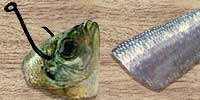

Current Report: Good To Very Good
SUMMER. In Summer, slow-moving water draws catfish to feed, in the shallows. Now scatter, locating cover in slightly cooler water. Reports indicate the most successful anglers are using nightcrawlers, cut bait, chicken livers, or shrimp. Fishing from late in the day until midnight is producing some of the best results, as this is their prime feeding time. The Weigand-Burbach area, with its jetties, is reported to be a good spot for catching catfish.
FALL. Fall is one of the best times of year for catching channel catfish. They migrate away from current to moderately deeper holes in the main channel of the lake. They remain in these areas and feed aggressively in preparation for Winter.
WINTER. In Winter, the channel cats gather in deep holes and go virtually dormant, especially if water cools into the 40's. They hole up in pockets from 15 to 30 feet deep and await warmer water. Slow presentations, especially cut bait, can still entice strikes. This is also a good time to catch a trophy-size channel cat.
SPRING. In Spring, when water temperatures rise into the 50's, channel catfish start their migration up shallow. The west end of the lake, where the Missouri River enters the lake, generally holds a good concentration of channel catfish. as well as blue and flathead catfish. They hold here, and feed aggressively, around relatively shallow cover until water warms into the mid 70's, at which time they begin the spawn process. Anglers are using slip sinkers, 3-way rigs, or Carolina rigs to keep baits close to the bottom. There are good numbers of 2 to 4 pound channel catfish being caught.
Fishing Video
Fish species to fish for...
Guide to fishing for largemouth bass, smallmouth bass, channel catfish, flathead catfish, blue catfish, black crappie, white crappie, walleye, bluegill, rock bass, white bass, northern pike, saugeye and sauger at Lewis And Clark Lake in South Dakota.

Lewis And Clark Lake is a 31,000-acre lake with 90 miles of shoreline. Enjoy catching walleye, sauger, saugeye, smallmouth and largemouth bass, catfish, yellow perch, white bass and crappie here. There's plenty of shoreline accessible for fishing from the bank, and ice fishing is popular in winter.
Primary fish species to catch
Click images for fishing tips and details about each species.
Today's Weather & Forecast
Fishing Boat Rentals
Click here for fishing boat rentals.
Public Boat Launch Ramps & Landings
Click here for boat ramps.
Marinas
Click here for marinas.
Fishing License
Click here for a South Dakota Fishing License.
Map - Fishing & Access
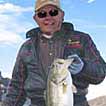
Rick Seaman is a fishing enthusiast with over five decades of fishing experience, a retired tournament fisherman, author of numerous published articles on fishing, and co-author of the book "Bass Fishing - It's not WHAT you throw, It's WHERE you throw it".
Contact Information
Lewis & Clark Recreation Area
43349 SD-52
Yankton, SD 57078
605 668-2985
Fishing lakes in each state
081425
Lewis & Clark Lake, SD Report
SOUTH DAKOTA


Fishing for walleye, bass and catfish at Lewis and Clark Lake in southern SD.




